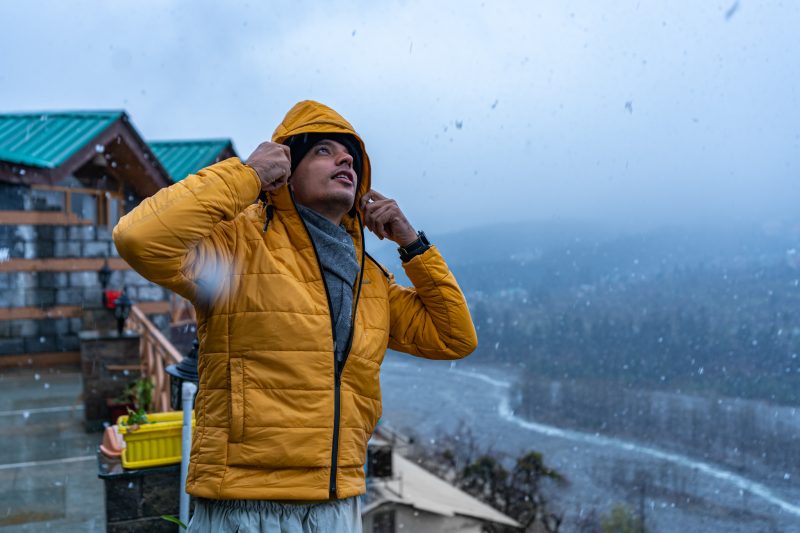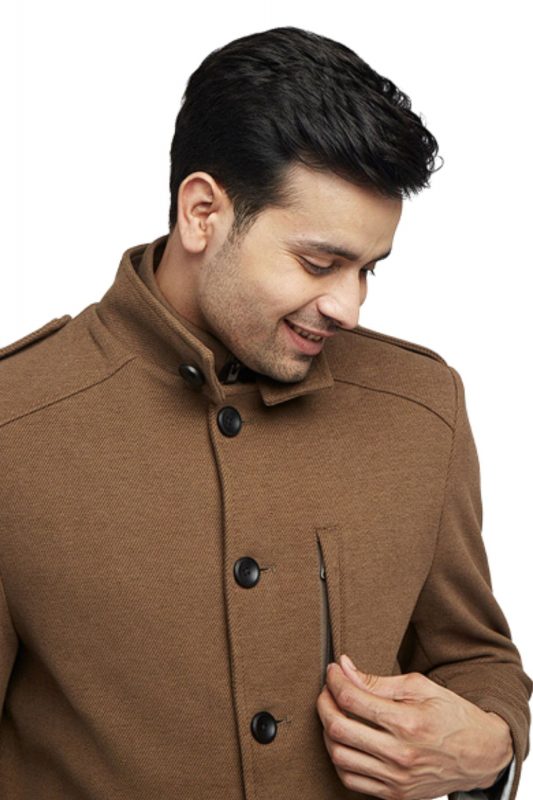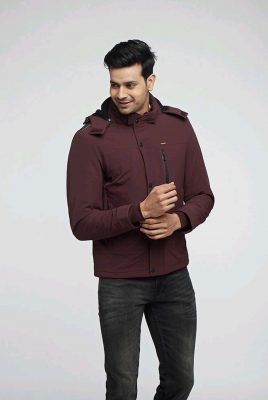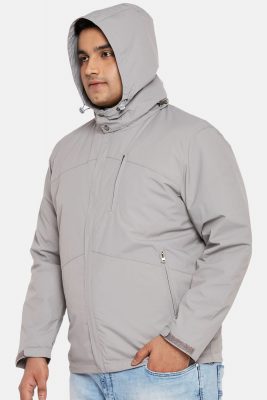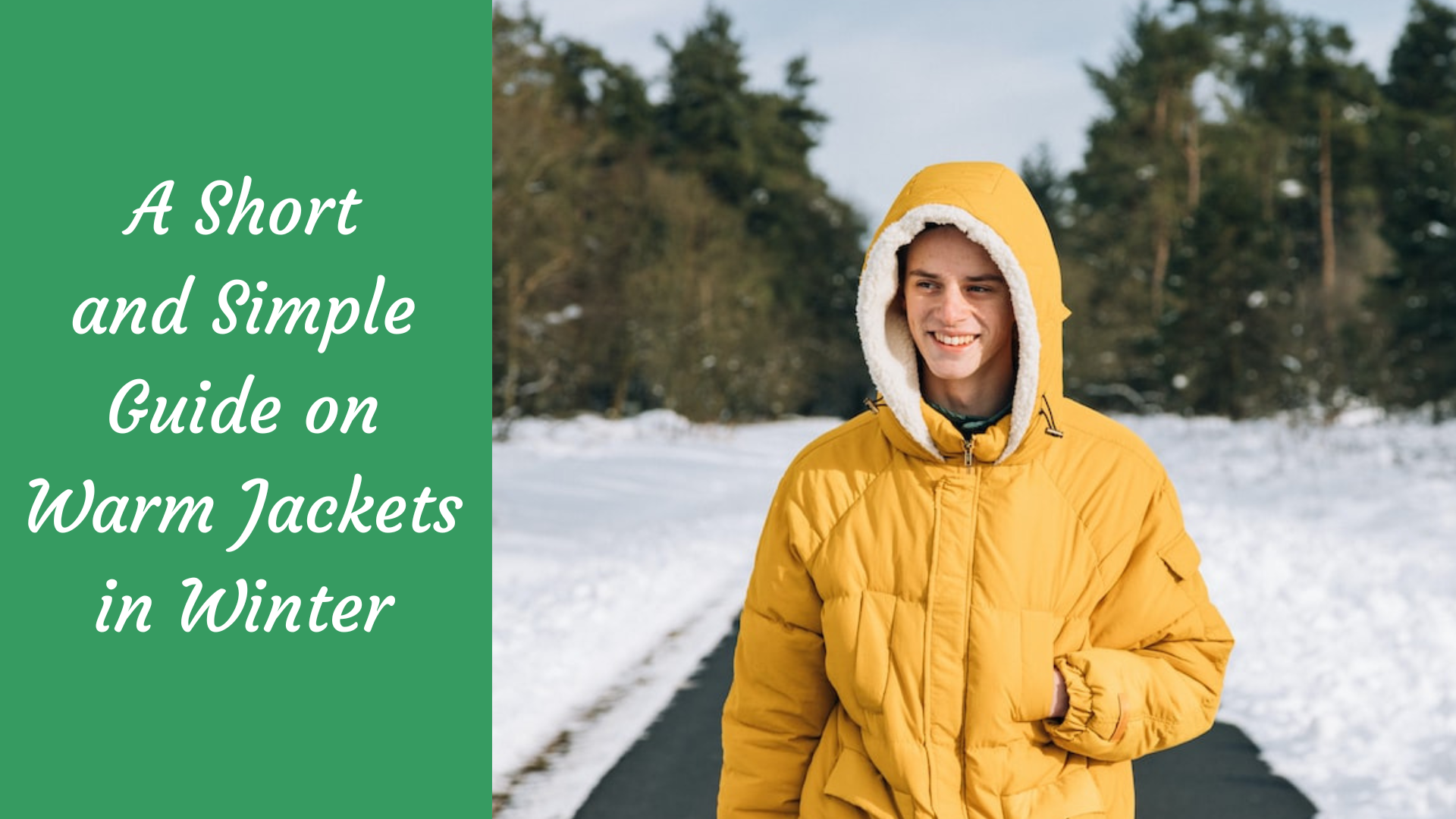
Table of Contents
A Short and Simple Guide on Warm Jackets in Winter
Guys and girls, how many winter jackets do you keep in your wardrobe for the season? Also, do they keep you warm throughout the season? If not, you should consider getting some warm jackets into your winter collection this season.
Warmth plays a significant role in any winter wear. After all, it must shield you from the cold winter days and elements. It applies to your winter jackets too. They’re the first line of defence in a layered outfit.
In this post, I’ll take you through a few essentials you must know about. It will help you when you go shopping for warm jackets this winter.
Things to Look For in a Winter Jacket
Yellow Lightweight Packable Puffer Jacket | Men
Certain things are common between normal as well as warm jackets. So before we get into warm jackets, let’s go through this segment. Here are some guidelines for you to pick suitable winter jackets.
1. Quality
It should always be quality over quantity for your clothing choices. It holds for jackets as well. You must ensure two things as a priority while buying winter jackets.
Your jacket is of good quality and made from superior material. If you get the quality, warmth will also follow.
2. Brand Value
Here’s something that matters a lot. Good brand value is associated with superior quality. It also develops your trust in the jacket’s effectiveness.
People might not mind spending a little more if they get the quality they want. And brands come with a promise of quality. Also, if you want a durable winter jacket, you must look for the best-suited ones available. The brand value will play a role here too.
3. Lining
Please also check the lining when you’re out to buy your warm jackets. The lining will tell you whether the jacket is of good quality or not. The lining should be sturdy and stitched to perfection.
There shouldn’t be a single loose thread or opening anywhere. If there is, the jacket will rip open after a couple of uses. Hence, you must ensure that the lining is good and sturdy. Otherwise, it’ll become tough for you to maintain the jacket.
4. Material
The material or fabric is one of the essential elements in a winter jacket. You’ll also see the options for your warm jackets later on.
But you need high-quality fabrics on your winter jackets at all times. It should help maintain the jacket for a longer period.
When it’s made from a finer quality, it’s natural that it will cost more. But you should invest in jackets with an eye on long-term goals. It will prove to be profitable because of the longevity factor.
You’d instead get it at a good price rather than buying it again and again. The latter will ensure you spend more for cheaper quality.
5. Fit
You should also look at getting the right fit for your body type. Apart from that, you should ensure that your fit is winter-friendly. For example, it should be able to keep out the wind. You’ll need a good, tight seal at the cuffs, neck, and waist of your jacket.
But, you don’t want to ruin the insulation while leaving room for wind. The insulation needs those air pockets to trap the warmth. That’s when the jacket will perform at its best.
So these are some of the essential features to get the right jacket. So, remember these basics while buying warm jackets too.
Now let’s move on to the specifics for warm jackets in winter.
How to Pick Warm Jackets
When you think of warm jackets, consider three categories:
- Down
- Fabric
- Waterproofing
Down jackets are a go-to coat for people who feel the chills in winter. But don’t neglect the other two.
These three factors will help you assess the warmth of your winter jackets for the season. So let’s take a deeper look at these three aspects.
1. Down
A down jacket uses the fuzzy under-feathers of ducks or geese to master the insulation.
There are tiny pockets trapped between the fluff. It helps in body heat retention.
When you shop for down jackets, you might get a “fill power” rating. It’s something you should be aware of. The higher the rating, the cosier your new purchase will be.
The fill power doesn’t refer to the number of feathers packed into the coat. It measures the loft or fluffiness of those feathers and their warmth-to-weight ratio.
The fluffier the feathers are, the more air pockets the down creates. It gives you maximum warmth with minimum bulk.
Down vs Synthetic
Geese down is the gold standard when it comes to down jackets. The duck down coats tend to be on the cheaper side.
2. Fabric
As you’ve read above, the fabric has a huge role. It is essential regardless of its composition or style. It impacts how warm and comfortable your warm jackets will be for you.
You’ll want a fabric that provides warmth and wicks away the moisture from your body. It’s ideal for a nice and comfy experience in the jacket.
Let’s look at a few fabrics that will help you out in that regard.
Wool
Wool will never go out of fashion till the time winter exists. It’s a classic winter staple, and it’s also a natural fabric. This feature has its benefits. It’s a brilliant insulator, and it’s breathable too.
Some types of wool might give you an itchy sensation. But in that case, look for a lined coat. It won’t bring back that itchy sensation.
Cashmere
Cashmere is among the softest and most luxurious fabrics for the winter climate. Apart from this, it’s an excellent insulator, too. It’s natural to assume that cashmere jackets have a hefty price tag. So if it doesn’t fit your budget, look for a cashmere-and-wool-blend instead.
Nylon
Nylon is the most durable fabric when it comes to warm jackets and coats. It has a downside, though. Nylon might take longer to dry compared to its lighter counterparts.
Polyester
Polyester is a good option f you want quick-drying warm jackets. Polyester tends to be cheaper and lighter than nylon. It might lag in durability, though. But it makes up with its moisture-wicking abilities. It drives sweat away from your body to keep you dry.
3. Waterproof Jackets
A jacket’s waterproof ability affects the amount of warmth you receive. During winter, you should stay away from damp clothing. It doesn’t help with comfort. Instead, it could bring up health concerns.
In some areas, rain is a possibility during winter. It could range from showers to torrential downpours. In all this, a waterproof jacket will keep you warm and dry.
“Showerproof” will shield you from short showers, but not unrelenting rain. “Water-repellent” jackets have a special coating to stop them from absorbing moisture, But they can let in water through gaps in the seams during sustained showers.
For maximum dryness, look for a fully waterproof coat featuring:
- Water-repellent coating
- Closed seams
- Breathable lining
- Fast-drying fabrics
Wine Lightweight Waterproof Fleece Lined Jacket
4. The Right Length
It all depends on what you’re up to. Suppose you’re planning to wear your jacket while skiing or hiking, a cropped jacket works. It will keep you snug without restricting any movement. It works for long walks on the streets too.
But, if you’re wearing your warm jackets for leisure, ensure to pick something that reaches mid-thigh level.
Sometimes, little things make the biggest difference. It applies to your ideal winter jackets too. Here are some extra design details that can make a difference in your warm jackets:
Stretchy, closed cuffs and adjustable drawstring hoods or hemlines trap the warm air inside your new buy.
Closed seams are essential for keeping both rainwater and whipping winds out.
5. The Importance of Wash-Care Instruction
Apart from knowing what to buy, you should know how to take good care of them too.
How you wash your winter coat can affect its performance and heat-keeping abilities. Speedy spin cycles can damage delicate down, while fabric softener wreaks havoc with waterproof coatings. Follow the care labels to avoid shortening its life span.
Some More Jacket Features
Fossil Plus Size 4-in-1 Jacket | Men
1. 3-in-1 Design
A 3-in-1 design is something you might not have heard of before. This jacket design has an integrated mid-layer and outer shell. It zips together or attaches via a few tabs.
You can wear the mid-layer or outer layer alone or together. Hence, you have three options. The insulation in the mid layer can vary from jacket to jacket. The outer shell will either be water resistant or offer waterproof and breathable coverage.
2. Hood
Some people might prefer a hoodless jacket because of the weight savings and packing ease.
Some hoods are detachable or have a zip inside the collar. A few hoods are insulated to provide added warmth.
If you’re a climber, you’ll need a “helmet compatible” hood. This feature will ensure that it’s big enough to fit over a helmet. Non-climbers may avoid this because it makes the hood a little unwieldy.
3. Adjustment Features
All the hood adjusters are usually on the sides of the jacket, with another at the back. Some hoods use an elasticized trim to create a sleek, less precise fit.
4. Drawcord
This feature is usually placed at the bottom hem. It blocks the wind and the cold air.
A few jackets have the draw cord on the waist instead.
5. Front Zipper
Most warm jackets have a chin guard on top and a storm flap in the front. But some jackets save weight with a water-resistant zipper instead of a storm flap.
A few jackets might have a two-way front zip. It lets you adjust the bottom opening for walking or sitting.
6. Cuffs
There are jackets with velcro tabs as well. It becomes easier to adjust wrist fit, sealing wind and cold air. But some jackets use an elasticized trim instead. It offers less bother and bulk and a less precise fit.
7. Pocket Features
More pockets offer more chances for storage. But it also adds to the weight and bulk. It could also raise the price of the jacket.
Zip, snap or velcro closures offer secure storage. But an open pocket provides faster access.
8. Zipper Protection
The exposed pockets on some jackets might have flaps for rain protection. At the same time, others have water-resistant zips to eliminate bulky flaps.
9. Hipbelt Compatibility
If your pockets are slightly higher, it ensures access while wearing a pack hipbelt.
10. Music Pockets
These pockets are found more often in urban jackets. They have a port inside for routing headphone cords.
11. Security pockets
These types are found in travel jackets. They’re inside the jacket with a hidden zip opening.
This opening is either along a seam or under a flap.
12. Drop-in pockets
These pockets are handy for storing a hat or gloves. These large open pockets are inside the jacket.
They’re directly behind the side pockets.
13. Vents
You’ll find vents when a jacket has a waterproof/breathable shell. This feature is primarily found on rain jackets. But a few insulated jackets include underarm vents or core vents. They’re handy when your exertion level rises in winter.
Maintaining Your Warm Jackets
It’s very essential to maintain your warm winter jackets. It keeps them going for longer periods. If you don’t pay much attention, get ready for wear and tear.
Here are some essential tips to take care of your warm jackets in winter:
1. Wash Them Carefully
It’s a given but you must pay attention while washing your winter jackets.. There are certain things that you need to follow.
are always stitched on the jacket itself. But, you can ask the sales person in case of a confusion. or you might even search online keeping the material of the jacket in mind.
Each material needs different type of care. Hence, if you want to make sure that you maintain your jacket, being aware of the wash care instructions is a must.
2. Dry Clean Once
Before you pack the jacket for summer, dry clean it once. Just like the skin requires cleansing, it’s important to cleanse your jacket.
You should do it properly before you store it. It’s something that will go a long way in ensuring the jacket’s longevity. So make sure that you follow this.
3. Dot Wash Them Often
Here’s another thing you should remember. The less you wash it, longer is the jacket’s life span. But, if you’re wearing the jacket often, you should put it out to air-dry. This will help in getting rid of any odour or germs that might have settled on the jacket.
4. Use a Mild Detergent
When you wash your jacket at home, always use a mild detergent. It shouldn’t affect the material and quality of your warm jackets. There are special detergent powders that are meant for these types of clothes.
So ensure that you use them only when you wash the warm jackets. This plays a role in the longevity too.
Wash care instructions are very important. Do make sure that you follow them and abide by them.
FAQ’s
1: What is a warm jacket?
A warm jacket is a piece of outerwear designed to keep you warm in cold weather. It is typically made of a thick, insulating material such as down, wool, or fleece. Warm jackets can also be waterproof or water-resistant to protect you from the elements.
2: What are the different types of warm jackets?
There are many different types of warm jackets, each with its own unique features and benefits. Some of the most popular types of warm jackets include:
-
Down jackets: Down jackets are known for their exceptional warmth-to-weight ratio. They are filled with down, which is a natural insulator that traps heat.
-
Puffer jackets: Puffer jackets are similar to down jackets, but they are filled with synthetic insulation instead of down. They are often more affordable than down jackets, but they may not be as warm.
-
Parkas: Parkas are long, heavy-duty jackets that are designed for extreme cold weather. They typically have a hood and a fur trim to protect you from the elements.
-
Fleece jackets: Fleece jackets are a lightweight, breathable option that is ideal for milder weather conditions. They are often used as layers under other jackets.
3: How do I choose a warm jacket?
When choosing a warm jacket, there are a few factors to consider:
-
The climate: Consider the climate you will be wearing the jacket in. If you live in a very cold climate, you will need a jacket with a high warmth rating.
-
The activity: Consider the activity you will be using the jacket for. If you will be hiking or skiing, you will need a jacket that is waterproof and breathable.
-
Your personal style: Choose a jacket that you like the look of and that fits you well.
4: How do I care for my warm jacket?
To care for your warm jacket, follow the care instructions on the label. Most warm jackets can be machine washed and dried. However, it is important to use a gentle cycle and to avoid using harsh detergents.
5: Where can I buy a warm jacket?
Warm jackets can be purchased from a variety of retailers, both online and in-store. Some popular retailers include:
- Kosha Travel Wear
- The North Face
- Columbia
- REI
- Amazon
Conclusion
I hope you’ve got an idea about warm jackets for your winter wardrobe. You should always keep warmth and comfort as your priorities. The rest will add value to your jacket.
There’s no point in wearing the best jackets if they don’t keep you safe in winter. So I hope that you get hold of some amazingly warm jackets this winter.
Have fun and enjoy the cold season with all the warmest winter wear options available.
This post was written by Kosha team member – Shawn Mathias
